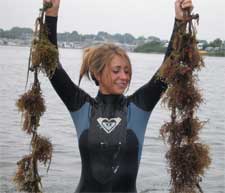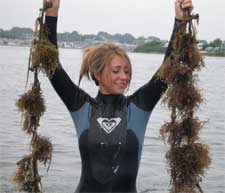 Middletown resident spends summer testing it’s potential
Middletown resident spends summer testing it’s potential
KINGSTON, R.I. – September 1, 2009 – University of Rhode Island senior Ariel Tobin decided to study fisheries and aquaculture because she loves sport fishing, she enjoys being on the water, and she knows it’s a field that will keep her attention. This summer she carried this enthusiasm into a research project to assess whether seaweed could become the next big food crop grown in the Ocean State.
“My focus has been on testing how to grow an edible seaweed called gracilaria in our salt ponds,” said Tobin, who was born in Key West, Fla., but grew up in Middletown. “It’s got a nice crispy, crunchy texture, a mild briny flavor, and its texture improves with cooking.”
Tobin collaborated on the project with Perry Raso, owner of Matunuck Oyster Farms, who raises oysters in a seven-acre aquaculture lease in Potter Pond in South Kingstown. His goal is to conduct the seaweed culture alongside his oyster farm to create an integrated aquaculture setting. Raso also owns a raw bar and restaurant, and he believes there is a market for gracilaria.
“Seaweed is essentially a sea vegetable, and it’s already popular in Asian markets,” Tobin said. “Marketing it here in New England might be a challenge, but it’s got great potential.”
To assess the viability of growing the species in a controlled aquaculture environment, Tobin conducted a variety of detailed tests to determine under what conditions it grows best. She first set up an experiment to learn in what depth water the seaweed grows fastest, then she studied the impact of tides and currents on growth rates.
She even followed up on a study in Canada that concluded that the ropes on which the seaweed is grown should be covered in vegetable shortening to reduce the likelihood that other organisms would attach to the ropes.
“That one didn’t turn out so well,” she said. “The vegetable shortening stopped the lines from being fouled by other seaweeds or tunicates, but it also inhibited the growth of the gracilaria we were trying to grow.”
On a typical day this summer, Tobin helped Raso monitor his oyster farm operations – raising oysters that start out the size of a grain of sand until they are ready to harvest at about three inches across – while also keeping track of her seaweed experiments. In addition, she conducted public tours of the facility.
“I spent a lot of time learning about the aquaculture operation, understanding the process involved in shellfish aquaculture, and improving my skills,” she said. “It was a great hands-on experience that I couldn’t have gotten any other way.”
With the help of mentors Carol Thornber at URI and Charles Yarish at the University of Connecticut, Tobin will spend the fall evaluating the data she collected and proceed to develop seaweed culture lines on a commercial scale. “I’m anxious to see a final product and for my research to come to fruition,” she said, “but I know that you cannot rush science.”
Tobin’s research was funded by Rhode Island Sea Grant and conducted through the URI Coastal Fellows Program, a unique initiative designed to involve undergraduate students in addressing current environmental problems. Now in its 14th year, it is based at URI’s College of the Environment and Life Sciences. Students are paired with a mentor and research staff to help them gain skills relevant to their academic major and future occupations.
When she completes her URI degree next May, Tobin looks forward to continuing her education and earning a graduate degree. “I’m in no rush to get out of school,” she said, “though I’m not sure where I will go. I might want to explore programs in other parts of the country.”
Then she hopes to work for the National Marine Fisheries Service as a regulatory observer aboard commercial fishing vessels and research ships. She worked on a URI research trawler in 2008, and she earned her SCUBA and boating certifications through her URI coursework, so she’ll be ready to go to sea when the time comes.
“My ultimate goal is to obtain a job where I’ll get to be out on the water, working to make a difference and improve our oceans,” she said. “It doesn’t feel like work when you’re doing what you love.”

